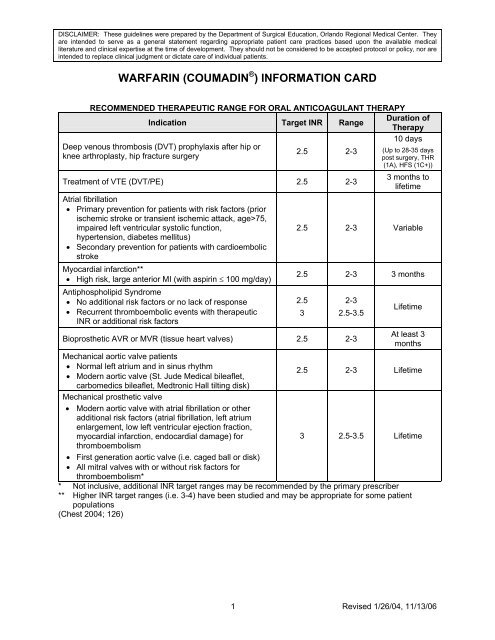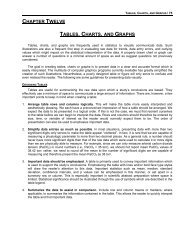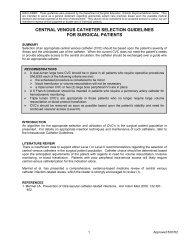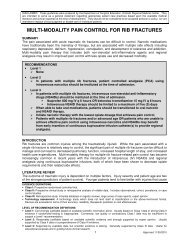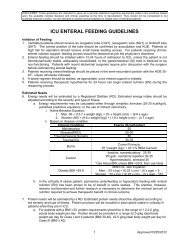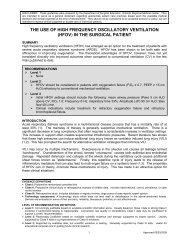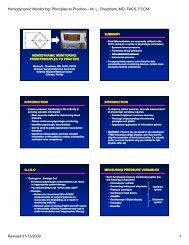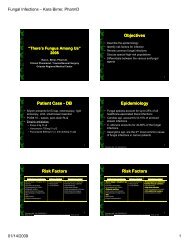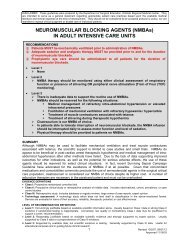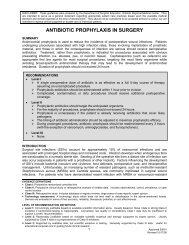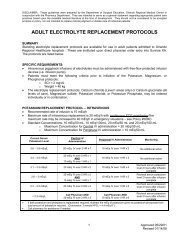warfarin (coumadin®) information card - SurgicalCriticalCare.net
warfarin (coumadin®) information card - SurgicalCriticalCare.net
warfarin (coumadin®) information card - SurgicalCriticalCare.net
Create successful ePaper yourself
Turn your PDF publications into a flip-book with our unique Google optimized e-Paper software.
DISCLAIMER: These guidelines were prepared by the Department of Surgical Education, Orlando Regional Medical Center. They<br />
are intended to serve as a general statement regarding appropriate patient care practices based upon the available medical<br />
literature and clinical expertise at the time of development. They should not be considered to be accepted protocol or policy, nor are<br />
intended to replace clinical judgment or dictate care of individual patients.<br />
WARFARIN (COUMADIN ® ) INFORMATION CARD<br />
RECOMMENDED THERAPEUTIC RANGE FOR ORAL ANTICOAGULANT THERAPY<br />
Indication Target INR Range<br />
Duration of<br />
Therapy<br />
10 days<br />
Deep venous thrombosis (DVT) prophylaxis after hip or<br />
knee arthroplasty, hip fracture surgery<br />
2.5 2-3<br />
Treatment of VTE (DVT/PE) 2.5 2-3<br />
Atrial fibrillation<br />
• Primary prevention for patients with risk factors (prior<br />
ischemic stroke or transient ischemic attack, age>75,<br />
impaired left ventricular systolic function,<br />
hypertension, diabetes mellitus)<br />
• Secondary prevention for patients with <strong>card</strong>ioembolic<br />
stroke<br />
Myo<strong>card</strong>ial infarction**<br />
• High risk, large anterior MI (with aspirin ≤ 100 mg/day)<br />
Antiphospholipid Syndrome<br />
• No additional risk factors or no lack of response<br />
• Recurrent thromboembolic events with therapeutic<br />
INR or additional risk factors<br />
(Up to 28-35 days<br />
post surgery, THR<br />
(1A), HFS (1C+))<br />
3 months to<br />
lifetime<br />
2.5 2-3 Variable<br />
2.5 2-3 3 months<br />
2.5<br />
3<br />
2-3<br />
2.5-3.5<br />
Lifetime<br />
Bioprosthetic AVR or MVR (tissue heart valves) 2.5 2-3<br />
At least 3<br />
months<br />
Mechanical aortic valve patients<br />
• Normal left atrium and in sinus rhythm<br />
• Modern aortic valve (St. Jude Medical bileaflet,<br />
2.5 2-3 Lifetime<br />
carbomedics bileaflet, Medtronic Hall tilting disk)<br />
Mechanical prosthetic valve<br />
• Modern aortic valve with atrial fibrillation or other<br />
additional risk factors (atrial fibrillation, left atrium<br />
enlargement, low left ventricular ejection fraction,<br />
myo<strong>card</strong>ial infarction, endo<strong>card</strong>ial damage) for<br />
3 2.5-3.5 Lifetime<br />
thromboembolism<br />
• First generation aortic valve (i.e. caged ball or disk)<br />
• All mitral valves with or without risk factors for<br />
thromboembolism*<br />
* Not inclusive, additional INR target ranges may be recommended by the primary prescriber<br />
** Higher INR target ranges (i.e. 3-4) have been studied and may be appropriate for some patient<br />
populations<br />
(Chest 2004; 126)<br />
1 Revised 1/26/04, 11/13/06
RECOMMENDATIONS FOR MANAGING ELEVATED INRs OR<br />
BLEEDING IN PATIENTS RECEIVING WARFARIN (CHEST 2004)<br />
Condition<br />
Description<br />
INR above therapeutic range, but < 5;<br />
no significant bleeding<br />
INR ≥ 5 but < 9; no significant bleeding<br />
Lower <strong>warfarin</strong> dose or omit dose, monitor more frequently,<br />
and resume at a lower dose when INR therapeutic; if only<br />
minimally above therapeutic range, no dose reduction may<br />
be required (Grade 2C)<br />
Omit next one or two <strong>warfarin</strong> doses, monitor more frequently<br />
and resume at lower dose when INR in therapeutic range.<br />
Alternatively, omit dose and give vitamin K (≤ 5 mg orally),<br />
particularly if at increased risk of bleeding. If more rapid<br />
reversal is required because the patient requires urgent<br />
surgery, vitamin K (2 to 4 mg orally) can be given with the<br />
expectation that a reduction of the INR will occur in 24 hours.<br />
If the INR is still high, additional vitamin K (1 to 2 mg orally)<br />
can be given (Grade 2C)<br />
INR ≥ 9;no significant bleeding Hold <strong>warfarin</strong> therapy and give higher dose of vitamin K (5-10<br />
mg orally) with the expectation that the INR will be reduced<br />
substantially in 24-48 hours. Monitor more frequently and use<br />
additional vitamin K if necessary. Resume therapy at lower<br />
dose when INR therapeutic (Grade 2C)<br />
Serious bleeding at any elevation of INR<br />
Life-threatening bleeding<br />
Hold <strong>warfarin</strong> therapy and give vitamin K (10 mg by slow IV<br />
infusion), supplemented with fresh plasma or prothrombin<br />
complex concentrate, depending on the urgency of the<br />
situation; recombinant factor VIIa may be considered as<br />
alternative to prothrombin complex concentrate; vitamin K<br />
can be repeated every 12 hours (Grade 1C)<br />
Hold <strong>warfarin</strong> therapy and give prothrombin complex<br />
concentrate supplemented with vitamin K (10 mg by slow IV<br />
infusion); recombinant factor VIIa may be considered as<br />
alternative to prothrombin complex concentrate; repeat if<br />
necessary, depending on INR (Grade 1C)<br />
* Vitamin K (Mephyton) is available as 5 mg tablets. For doses which can not be obtained with the<br />
tablets, the vitamin K injectable solution can be given PO<br />
** SC route may produce unpredictable absorption therefore the PO route is preferred due to faster<br />
absorption and more predictable effectiveness<br />
*** IV route may produce anaphylactic reaction<br />
(Chest 2004;126: 204S – 233S)<br />
2 Revised 1/26/04, 11/13/06
REPRESENTATIVE DRUG AND FOOD INTERACTIONS WITH WARFARIN*<br />
Level of Evidence Potentiation of anticoagulation Inhibition of anticoagulation<br />
I<br />
Alcohol (if concomitant liver disease),<br />
amiodarone, anabolic steroids,<br />
cimetidine, clofibrate, cotrimoxazole,<br />
erythromycin, fluconazole, isoniazid (600<br />
mg daily), metronidazole, miconazole,<br />
omeprazole, phenylbutazone, piroxicam,<br />
Barbiturates, carbamazepine,<br />
chlordiazepoxide, cholestyramine,<br />
griseofulvin, nafcillin, rifampin,<br />
sucralfate, high vitamin K content<br />
foods/enteral feeds, large amounts<br />
of avocado<br />
propafenone, propranolol,<br />
sulfinpyrazone<br />
II<br />
Acetaminophen, chloral hydrate,<br />
ciprofloxacin, dextropropoxyphene,<br />
disulfiram, itraconazole, quinidine,<br />
phenytoin, tamoxifen, tetracycline, flu<br />
Dicloxacillin<br />
III<br />
IV<br />
vaccine<br />
Acetylsalicylic acid, disopyramide,<br />
fluorouracil, ifosphamide, ketoprofen,<br />
lovastatin, metozalone, moricizine,<br />
nalidixic acid, norfloxacin, ofloxacin,<br />
propoxyphene, sulindac, tolmetin, topical<br />
salicylates<br />
Cefamandole, cefazolin, gemfibrozil,<br />
heparin, indomethacin, sulfisoxazole<br />
Azathioprine, cyclosporine,<br />
etretinate, trazodone<br />
* For a more complete listing and its potential impact on the patient’s INR, please contact your<br />
pharmacist<br />
(Chest 2004;126: 204S – 233S)<br />
3 Revised 1/26/04, 11/13/06
GENERAL STANDARDS FOR THE INITIATION<br />
AND MAINTENANCE OF WARFARIN (COUMADIN®) THERAPY<br />
Initiation of <strong>warfarin</strong> (Coumadin®)<br />
5 mg nomogram<br />
Maintenance of <strong>warfarin</strong> (Coumadin®)<br />
Based on a therapeutic INR 2.0 - 3.0<br />
Day INR Dosage INR Weekly dose change<br />
1 5 mg < 1.1 Consider reinitiation<br />
2<br />
3<br />
4<br />
5<br />
6<br />
< 1.5<br />
1.5-1.9<br />
2.0-2.5<br />
> 2.5<br />
< 1.5<br />
1.5-1.9<br />
2.0-2.5<br />
2.5-3.0<br />
> 3.0<br />
< 1.5<br />
1.5-1.9<br />
2.0-3.0<br />
> 3.0<br />
< 1.5<br />
1.5-1.9<br />
2.0-3.0<br />
> 3.0<br />
< 1.5<br />
1.5-1.9<br />
2.0-3.0<br />
> 3.0<br />
5 mg<br />
2.5 mg<br />
1-2.5 mg<br />
0 mg<br />
5-10 mg<br />
2.5-5 mg<br />
0-2.5 mg<br />
0-2.5 mg<br />
0 mg<br />
10 mg<br />
5-7.5 mg<br />
0-5 mg<br />
0 mg<br />
10 mg<br />
7.5-10 mg<br />
0-5 mg<br />
0 mg<br />
7.5-12.5 mg<br />
5-10 mg<br />
0-7.5 mg<br />
0 mg<br />
1.1-2.0<br />
Consider increasing weekly dose by<br />
10-20%<br />
2.0-3.0 Maintain same dose<br />
3.0-3.9<br />
> 4.0<br />
Consider decreasing weekly dose<br />
by 10-20%<br />
Consider holding a dose and<br />
decreasing weekly dose by 20%<br />
Points to Remember in Initiating Therapy<br />
• Check INR at least 4 times during the first<br />
week of therapy<br />
• User lower initial dose (2.5-5 mg) if: Age ><br />
75, weight < 60 kg, interacting medication<br />
known to potentiate <strong>warfarin</strong>, hepatic<br />
dysfunction, severe heart failure, renal<br />
dysfunction, hypoproteinemia, impaired<br />
nutritional intake, and increased baseline<br />
INR (i.e., >1.4)<br />
• Use higher initial dose (5-10 mg) if: Younger<br />
patients, interacting medications known to<br />
diminish <strong>warfarin</strong> effects, and a diet rich in<br />
Vitamin K<br />
Ann Intern Med 1992;116(11):901-904<br />
Ann Intern Med 1997;127(4):333<br />
J Clin Pathol 2002;55:845-849<br />
Points to Remember in Maintenance Therapy<br />
• If patient is on outpatient <strong>warfarin</strong> therapy,<br />
use the home dosage as a guide when<br />
continuing <strong>warfarin</strong> therapy in the hospital<br />
• Monitor INR for medication administration,<br />
changes in interacting drugs, liver function<br />
changes, <strong>card</strong>iac function changes, and<br />
changes in diet<br />
• Once on therapy for > 1 week, dose<br />
modifications between 5 to 20% are<br />
recommended. Larger changes, such as<br />
changing the weekly dose by one third can<br />
overcorrect an abnormally high or low INR.<br />
Recheck an INR within 4-6 days after<br />
adjustment for abnormal INR<br />
Am J Med 2000;109:481-488<br />
Circulation. 2003; 107:1692-1711<br />
4 Revised 1/26/04, 11/13/06


